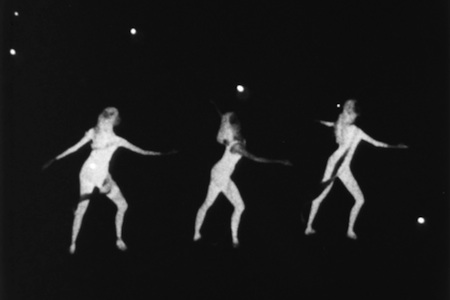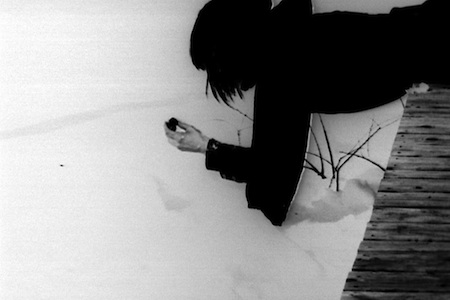In 1928, when Germaine Dulac premiered her (then unlabeled) surrealist film The Seashell and the Clergyman to scratching heads and shrugging shoulders, she was working with a racy topic for its time. Seashell offered a blurry, trippy account of a priest in spiritual crisis: he desperately wants to make love to another man’s wife. Dulac’s brilliance was in creating steamy hallucinatory imagery as foil for the straightforward scenes of the clergyman’s life. Like so many artists who are out there shaking bushes, Dulac’s treatment of an Antonin Artaud idea was met with skepticism. At the time, the British Board of Film Censors, considering it potentially objectionable, deemed Seashell to be “apparently meaningless.” The irony is that if one to were to watch Seashell today, one could easily mistake it for a David Lynch film.
Then there’s Maya Deren, experimental filmmaking royalty. Her 1958 experimental short The Very Eye of Night—which visualizes dancers as photographic negative ballet figures in space—was a striking contrast to CBS’s choreographed, single crane-mounted camera broadcast of Balanchine’s Nutcracker that same year. Similarly, Shirley Clarke’s short film Bridges-Go-Round could also be viewed as a companion piece to Deren’s film, since Clarke’s visuals seem to “dance” around the bridges and architecture of New York City.
Watch Women Unseen: Avant-Garde Film:
What Deren and Clarke were able to do, without falling under the hard rock of public criticism, was capitalize on the then under-the-radar role of the woman filmmaker in order to experiment and challenge the norms of conventional moviemaking. In layman’s terms, the through line between Dulac and the works of Deren and Clarke is the continued practice of moving the image out of the literal. By reshaping what was in front of our eyes, these avant-garde filmmakers were able to bring out a different kind of truth, one that was more complex and harrowing.
Modern women of the avant-garde—Lori Felker, Jennifer Reeves and Janie Geiser—are in a sort of historical dialogue with Dulac, Clarke and Deren. Consider: If obfuscation (taking the obvious image and diffusing it down to its less glamorous parts) was masterstroke for the earlier trio, then this modern trio is interested with themes of restoration. It’s restoration in the aspect of rebuilding clarity or tidiness. Instead, Felker, Reeves and Geiser are tasked with assembling already beclouded elements into some kind of new notion or higher truth.
In Geiser’s Ghost Algebra, for example, she literally works with physical matter (natural objects, bones etc.) in a motion collage that attempts to solve the most problematic of equations, the one with the open-ended answer. But if one looks closer at Reeves’ Light Work I, it’s not just about the simple assembly of parts. It’s a dense and overwhelming sensory survey of a century’s worth of industrial progress. It’s easy to mistake Light Work I as another avant-garde piece hinged on obliterating the image but it’s doing so much more than that. Clarke was able to obfuscate the familiar NYC architecture into a spinning visual dance whereas Reeves puts 100 years of technological and medicinal progress into a blender and confidently expects viewers to process the information on a subliminal level. It’s the most radical of reassemblies.
Finally, with Felker’s Imperceptihole, the female avant-garde narrative reaches an apex for both sociological and artistic merit. The film is an actual correspondence piece between Felker and filmmaker Robert Todd. Through Felker’s reassembly (i.e. restoration) of sound and image between the female vision (hers) and the male vision (Todd’s), Impercepithole plays more like a cross-section of the traditional narrative going through freefall. A story feels like it’s buried in the bursts of light that crack through the screen, along with a genuine searching for truth around the edges of the frame.
What’s most compelling about these avant-garde works and the female filmmakers behind them, is how both old and new, they are able to maintain their enigmatic power, mystery and re-watch value in an age where everything can be Googled or deciphered.
Nelson Carvajal is an independent digital filmmaker, writer and content creator. His video essays on cinema have been published on indieWIRE’s Press Play and Fandor’s Keyframe. Carvajal’s video art pieces and experimental short films have screened at the London Underground Film Festival, the 0110 International Digital Film Festival and the Oregon Independent Film Festival. You can follow him on Twitter.





